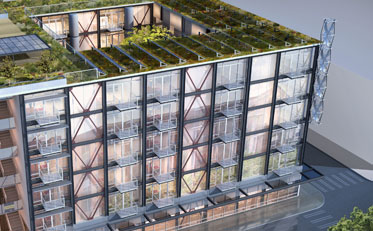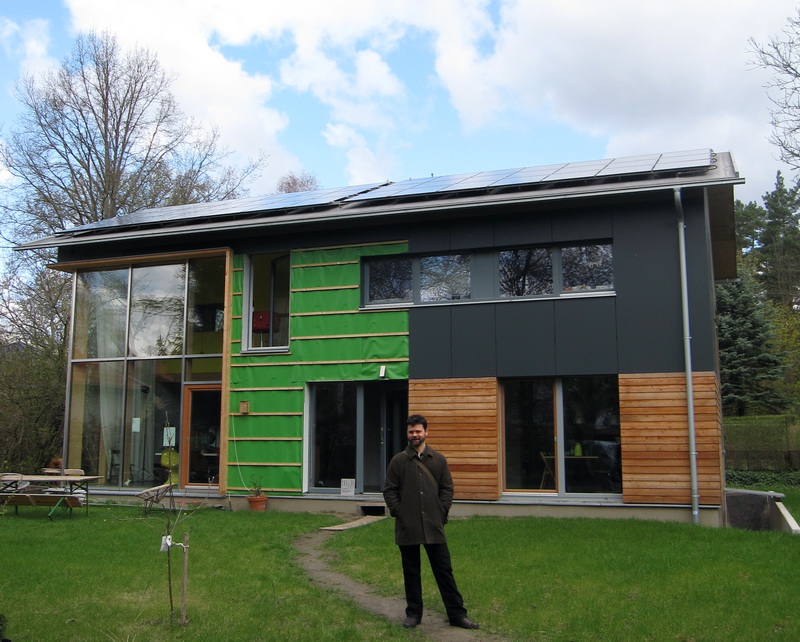During my trip to Germany last week, one of my hosts from the Böll Foundation and I took a morning commuter train up to Borgsdorf, north of Berlin, to visit an experimental passivhaus built by architect Oliver Jirka for his own family. Here’s your faithful correspondent on the scene:
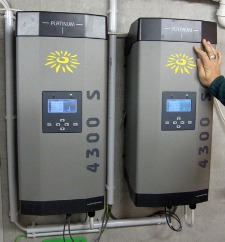 Digital readouts show hourly/daily/weekly output of solar panels.The house has been the subject of several news stories (here’s one in English). The first thing that struck me is that it looks like a house — sleek and modern, but nothing particularly wacky or unusual. I only note that because energy-wise it’s extraordinary: It gathers ambient energy and feeds it into the grid. That is to say, it’s an energy generator, not an energy consumer.
Digital readouts show hourly/daily/weekly output of solar panels.The house has been the subject of several news stories (here’s one in English). The first thing that struck me is that it looks like a house — sleek and modern, but nothing particularly wacky or unusual. I only note that because energy-wise it’s extraordinary: It gathers ambient energy and feeds it into the grid. That is to say, it’s an energy generator, not an energy consumer.
It will take Jirka about a decade to pay off the solar panels on the roof, but from that point on, his energy bills will be … well, not bills. They’ll be payments, an income stream rather than the income sink familiar to most of us homeowners.
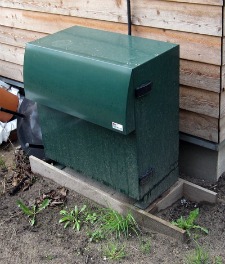 The ventilation intake and filter.The side of the house I’m on, with all the windows, faces south; all passivhaus design orients toward the equator. That two-story window in the southwest corner gathers heat, which is then trapped by glass (which contains argon) and walls 40 centimeters thick. Those walls are stuffed with insulation made of shredded newspaper.
The ventilation intake and filter.The side of the house I’m on, with all the windows, faces south; all passivhaus design orients toward the equator. That two-story window in the southwest corner gathers heat, which is then trapped by glass (which contains argon) and walls 40 centimeters thick. Those walls are stuffed with insulation made of shredded newspaper.
The house’s joints are sealed tight, but there’s a sophisticated ventilation and filtering system that keeps the interior air fresh and, Jirka told me, cleaner than outdoor air.
On the roof is a cutting-edge water-cooled solar PV system. (Jirka says water-cooled PV is only about 1 percent of the market now but advancing quickly.) Panels get less efficient as they heat up, so active cooling can boost efficiency by something like 15 percent in hot weather.
The water that cools the panels carries heat into the home for use as hot water and space heating. There’s a heat pump too, and a heat exchanger, but I’ll hash the details if I try to explain how they work. It has to do with the differences in air temperature and the temperature down a few feet below the ground.
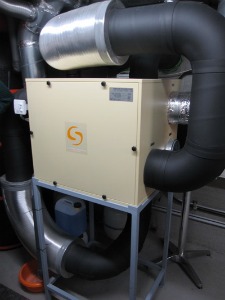 The heat exchanger in the basement.Suffice to say, it’s ingenious, but what really struck me is how low-tech (“appropriate tech”?) most of it is. There’s a digital readout for the solar panels, but other than that the technology mostly involves thick walls and tubes to move air and water around. The sun and earth provide the energy; all the house does is situate itself cleverly within those energy flows. That’s what dematerialization is all about: substituting careful design for the brute force of fossil-fuel combustion.
The heat exchanger in the basement.Suffice to say, it’s ingenious, but what really struck me is how low-tech (“appropriate tech”?) most of it is. There’s a digital readout for the solar panels, but other than that the technology mostly involves thick walls and tubes to move air and water around. The sun and earth provide the energy; all the house does is situate itself cleverly within those energy flows. That’s what dematerialization is all about: substituting careful design for the brute force of fossil-fuel combustion.
Jirka isn’t just getting involved in his own energy needs, he’s pushing his neighbors to get involved too. Recently he pulled together dozens of local investors to fund a big 30kW PV system on the town’s community center. Now they have have a direct, personal stake in the area’s energy future.
Jirka and his neighbors want to own and control their own energy supply, rather than leaving it in the hands of a giant, far-off utility. It’s hard to put a dollar value on that kind of self-reliance and civic spirit, but lots of folks in Germany seem willing to pay a little extra for it.
